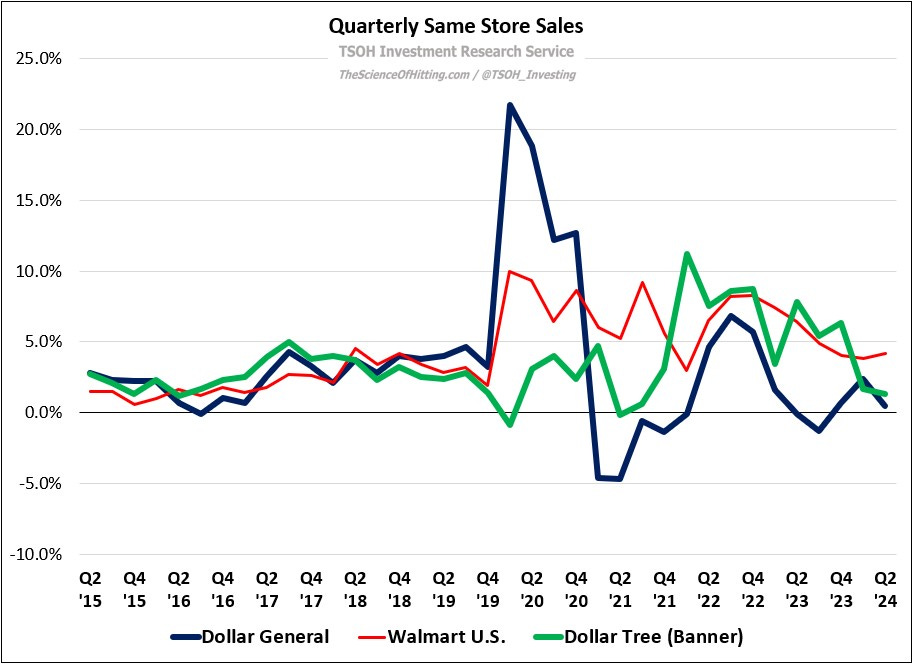DG Tegus Panel Discussion
On August 29th, a few hours after Dollar General (DG) reported its Q2 FY24 results, I moderated a Tegus panel call with three former DG employees who were each responsible for overseeing numerous stores during their time with the company. The discussion is now available for free. Personally, I found their perspective insightful. They shared their views on a number of topics, including the state of the competitive landscape, Dollar General’s operational challenges, and the path to stronger long-term financial performance at DG. (As a reminder, Monday’s TSOH post was an update on DG and DLTR.)
Here are three comments from the discussion that stood out to me.
On DG’s current challenges, Gary said the following (20th minute):
“I don't know that the executives really understand the failure to be able to execute, because nobody ever shows them reality. They take their tours and go out to the stores, but it's smoke and mirrors. They are given the illusion that everything's okay and that everybody can execute based on what they're seeing in a small snapshot, but they never really see reality. Until they step back and see what it really looks like and how everything's really executed in the stores, they won't fix it… It really goes back to everything else. It's the lack of staffing within stores to be able to execute at that high level. It can be done, but you haven't retained the people or those people haven't been there long enough to understand the big picture… It's become a perpetuating problem. So, they really have to see reality and take the time to do more surprise-type visits where they don’t announce where they're going. If they do, I think they'll start to peel back the onion and see what it really looks like, to figure out what they need to do to fix it.”
On DG Fresh and Family Dollar, Shawn said the following (32nd minute):
“The concept was great in theory, [but] in certain areas of the country the distribution centers were not able to take on that additional capacity… What we experienced in the South was delayed deliveries, expired deliveries, thawed out deliveries, fresh deliveries being put on trucks without cooling / refrigerant capabilities, being routed for too far of a distance away from the distribution center, plus taking away truck capacity for dry goods. So, while the fresh initiative was good in theory, there was major transportation issues and distribution channel issues, at least in the South… On Family Dollar, Dollar General potentially has an extreme opportunity across the nation with what's going to happen with Family Dollar… The upside for DG, if they get some of these things figured out from a staffing and an execution perspective, is that they can really seize the opportunity where they have a direct competitor [a nearby store] with Family Dollar.” (On that last point, see the examples discussed in “The Road To Recovery”.)
On driving operational improvements, Trey said the following (40th minute):
“You asked specifically, was anything different five years ago? I think all the SOP’s [standard operating procedures] are the same. What they're supposed to be doing has not changed. What has changed is the consumer and what the employee base demands. It's always been there, because even five or six years ago I was getting these type of complaints, dealing with these type of employee relations issues. I think the difference is [employees] have a voice now with social media… that TikTok thing happened a few years back, and it was all about that same thing: a store manager is expected to do all these different roles. The store manager is not really a manager. There's workplace lawsuits that were brought up around, ‘Are they leading and delegating 50% or more of their time?’, which they're not. Here’s another thing that changed: when I first came on, in a typical market, I’d say a district manager (DM) would have about 20 stores. But it was very well known they wanted DM’s to be closer to 22 to 25 stores. You can't run 25 independent businesses with that many moving parts. That's a huge span of control for one person… In most organizations, the DM is the closest person to the execution of the vision in the field, of what the merchants and the executive team wants. They're the ones that get the field inspired or engaged to go do it. And when you are trying to essentially convince 25 store managers and 25 assistant managers to do it, you just need to pull back the scope a little bit - to give DM’s more control and more time back to be invested into those folks.”
While many of these ideas are not new (understood by investors), I found the conversation was useful in terms of truly contextualizing some of the key operational considerations at Dollar General. There’s much more of value in the discussion beyond these quotes; if the retail industry is something that you are interested in, I think you will find the discussion well worth your time.
Finally, a big thank you to the Tegus team for their behind the scenes work on setting up the panel, as well as to the three experts for sharing their insights.
NOTE - This is not investment advice. Do your own due diligence.
I make no representation, warranty, or undertaking, express or implied, as to the accuracy, reliability, completeness, or reasonableness of the information presented in this report. Assumptions, opinions, and estimates expressed in this report constitute my judgment as of the date thereof and are subject to change without notice. Projections are based on a number of assumptions, and there is no guarantee that they will be achieved. TSOH Investment Research is not acting as your advisor or in any fiduciary capacity.


